You’d be hard-pressed to find anyone who disagrees bout the benefits of pull-ups for building a broader and stronger back. But what if you struggle to do pull-ups or even chin-ups? Is there anything else you can do? You bet! Below, I share 7 pull-up alternatives you can do with resistance bands.
Pull-up alternatives can be performed using resistance bands. Exercises such as the pull-down, reverse fly, row, and pull-apart work a similar variety of back muscles as pull-ups and chin-ups. These include the latissimus, trapezius, and rhomboids.
Before I learned how to do the unassisted pull-up, I first mastered band-assisted pull-ups. And before I learned how to do banded pull-ups, I mastered the resistance band pull-up replacement exercises listed below.
They worked for me, so I hope they can work for you too!
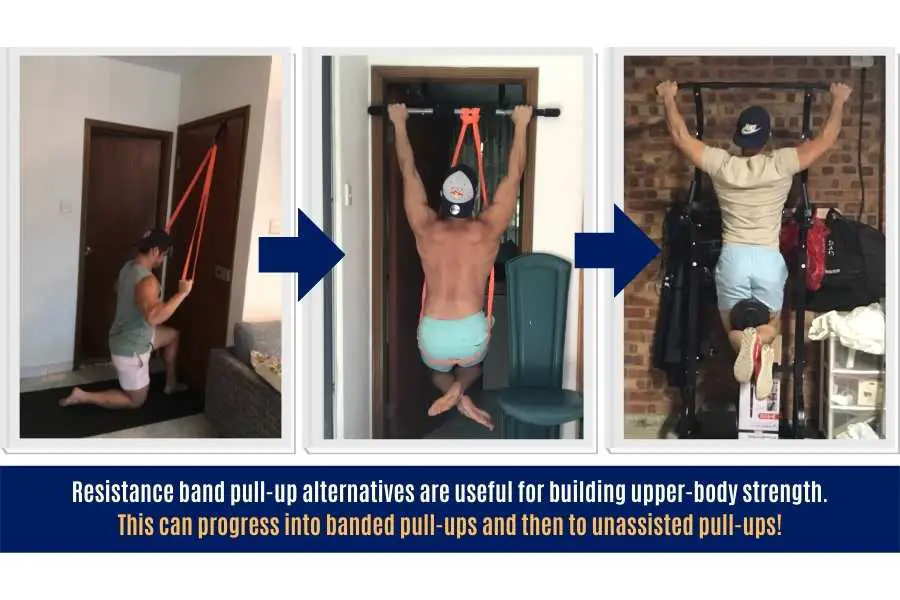
- Best Resistance Bands To Do Pull-Up Alternatives
- Muscles Worked In The Resistance Band Pull-Up
- 7 Resistance Band Alternatives To Replace Pull-Ups
- What's The Best Resistance Band Alternative To Replace Pull-Ups?
- Benefits Of Doing Resistance Band Pull-Ups
- Why I Recommend The Undersun Resistance Bands For Pull-Up Alternatives
- Conclusion
Best Resistance Bands To Do Pull-Up Alternatives
Throughout this post, I demonstrate 7 of my favorite pull-up alternatives using the Undersun resistance bands.
I’ve tried half a dozen different brands of bands- cheap and expensive- and honestly recommend these as the best value for money.
The Undersun set comes with 5 different bands that offer a variety of tension levels.
The light bands are ideal for pull-apart and reverse flies, whilst the heavier bands are perfect for pull-down movements. All of these movements make for great pull-up substitutes.

Best of all, they come bundled with a high-quality door anchor (not a cheap one as is often the case with the budget Amazon brands).
The anchor is essential for safely securing your bands at different heights to get the perfect angle to work your back.
Without a good anchor, it’s impossible to get the same angles. And you’ll have to make do with mediocre training benefits.
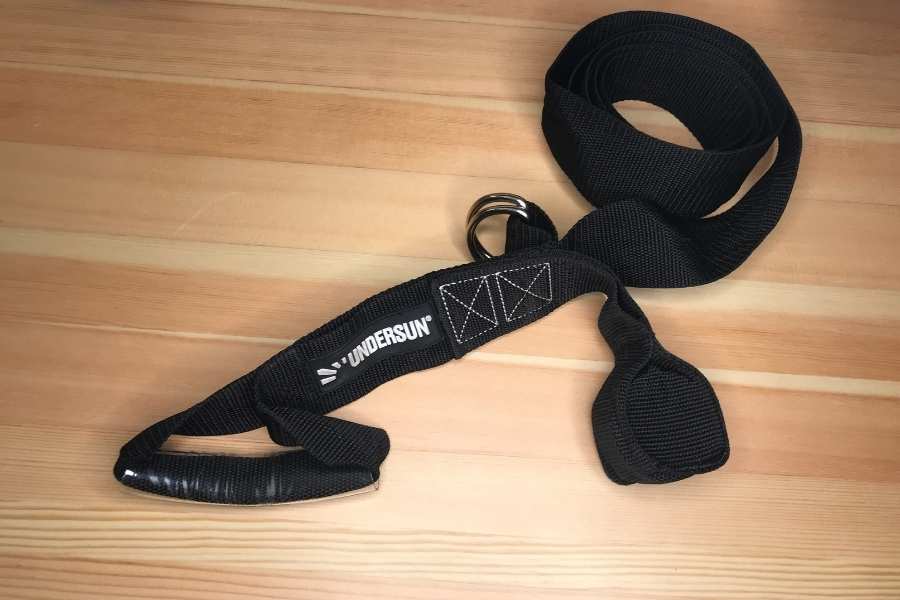
Additionally, the anchor is made from a heavy-duty fabric that has lasted me for years. But the point of contact with the band is vinyl, which protects your resistance bands from tearing and eventually snapping (yes resistance bands can snap!).
Muscles Worked In The Resistance Band Pull-Up
The banded pull-up works the same muscles as the unassisted pull-up. All of the upper-body muscles are activated to a certain degree. But the emphasis is on the back muscles which include the trapezius, rhomboids, and latissimus dorsi.
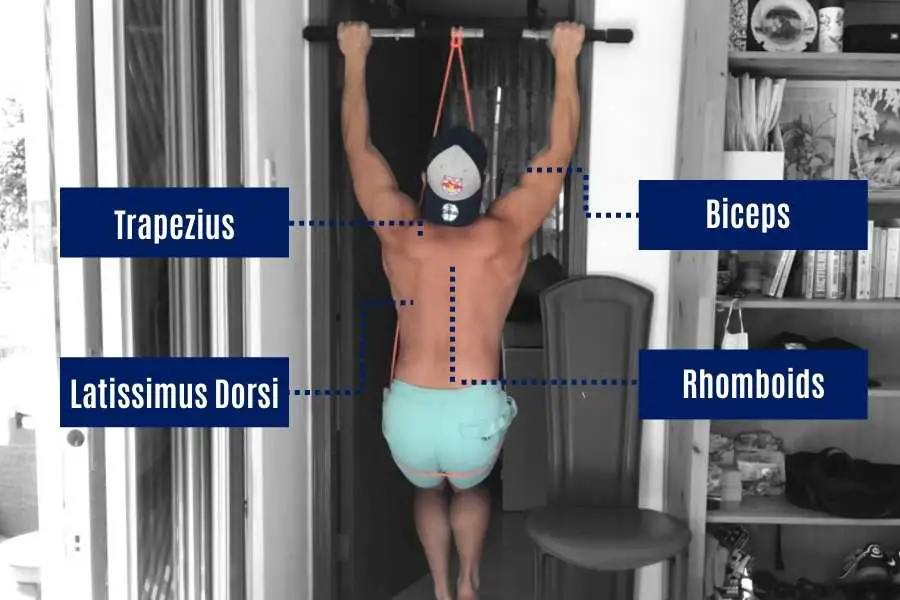
Understanding which muscles are worked in the pull-up/chin-up allows you to choose suitable replacement exercises that work the same muscles.
Here are the individual muscles targetted in the pull-up/chin-up and how resistance bands can be used to replicate similar movements:
| Muscles Worked In The Banded Pull-Up | Movement and Role |
|---|---|
| Trapezius | Stabilizing the shoulders as you perform the pull-up. |
| Rhomboids | Shoulder blade retraction during the upward motion. |
| Latissimus dorsi | Shoulder extension and flexion. |
| Biceps | Elbow extension and flexion. |
| Abdominals | Core stability and balance. |
| Shoulders and chest | Stabilizing the torso throughout the movement. |
You can see that it’s mainly the back muscles being worked in the banded pull-up/chin-up.
But the biceps also work to flex your elbows as you bring your body towards the bar.
Additionally- the abdominals, shoulders, and chest are also activated to stabilize and keep your torso balanced during the movement.
Now that you know which muscles are worked when performing pull-ups with resistance bands, we can choose a selection of exercises to target these muscles without having to do the pull-up itself!
7 Resistance Band Alternatives To Replace Pull-Ups
Pull-ups and chin-ups can be replaced with alternative resistance band movements. Exercises like the banded pull-down, row, and pull-apart simulate the movement of a pull-up. They can therefore work similar muscles and be used instead of the pull-up.
Whilst the band pull-up and chin-up are great exercises for a beginner, they are not always viable movements.
You may not have a bar at home. Or you might simply prefer to concentrate on a selection of less technical movements before progressing onto the pull-up/chin-up.
Here are 7 pull-up alternatives you can use with resistance bands:
1) Lat Pull-Down With Resistance Bands
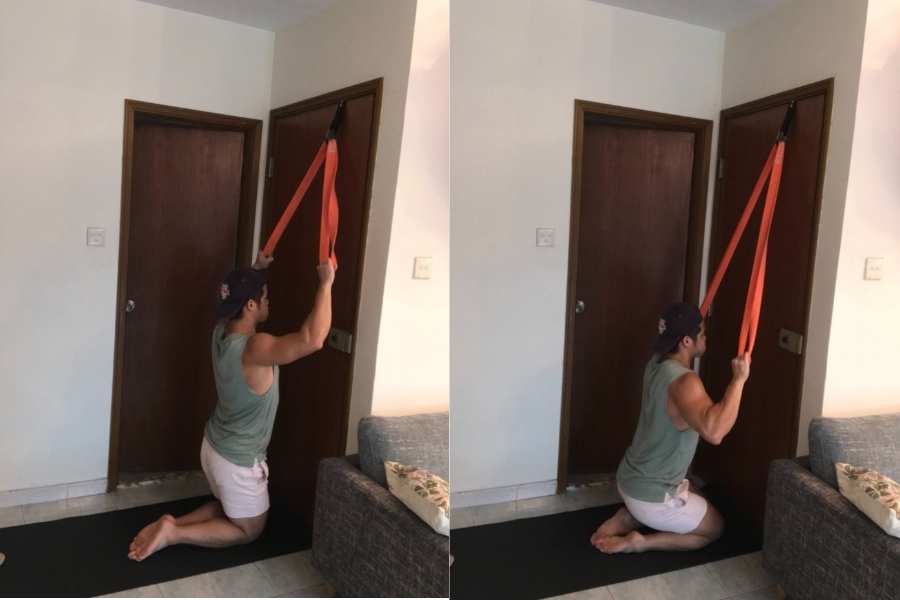
Primary muscles worked:
- Latissumus dorsi.
- Rhomboids.
- Trapezius.
- Biceps.
Secondary muscles worked:
- Core.
- Shoulders.
- Chest.
How to do it:
- Anchor a resistance band above the head (e.g. to the top of a door).
- Hold both ends of the band at a shoulder-width distance apart.
- Keep a slight bend in the elbows and pull the band towards the shoulder blades.
- Retract the shoulder blades to achieve a full range of motion.
Why it’s a great resistance band alternative to replace pull-ups and chin-ups:
This exercise is the next best thing when you want to simulate the movement of the bodyweight and banded pull-up/chin-up.
The lat pull-down is a great pull-up alternative using resistance bands.
It’s essentially the same movement and activates similar muscles.
But instead of pulling your body weight, you’re pulling on resistance bands.
And that’s much easier!
2) Straight-Arm Resistance Band Pull-Down
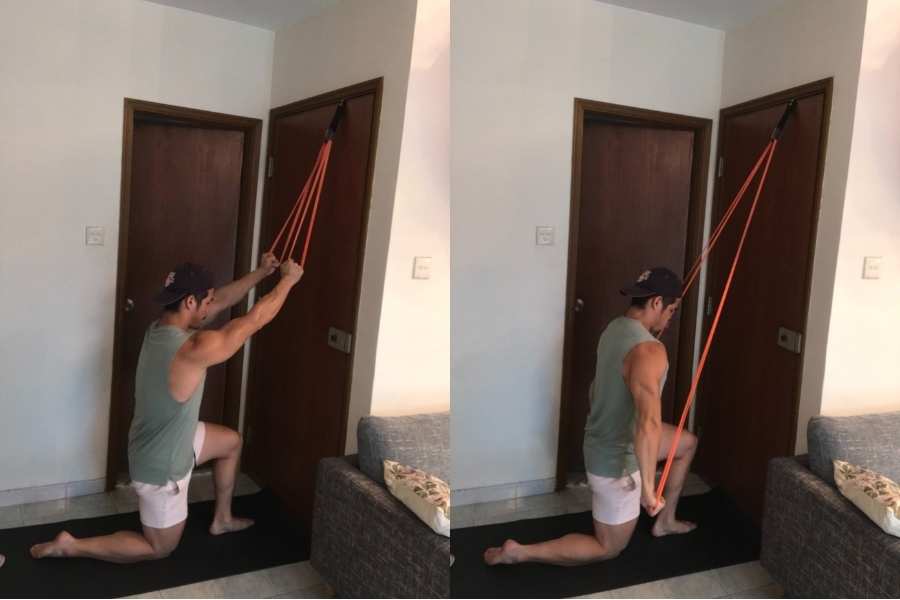
Primary muscles worked:
- Latissumus dorsi.
- Rhomboids.
- Trapezius.
Secondary muscles worked:
- Biceps.
- Core.
- Shoulders.
- Chest.
How to do it:
- Anchor a resistance band above your head.
- Grab either end using a straight arm and stand far enough back to generate a slight tension in the band to keep it taught.
- Bend knees and lean forward.
- Keep both arms straight and arc them down whilst retracting the shoulder blades.
Why it’s a great resistance band alternative to replace pull-ups and chin-ups:
This is another effective pull-up/chin-up replacement using resistance bands.
It’s a similar movement to the pull-up and mainly activates the back muscles.
This makes it an awesome movement to simulate the motion of a pull-up using your bands.
Unlike the pull-up, the pull-down removes the requirement for the elbows to flex since the arms are kept straight.
Therefore it’s generally easier for a beginner to do the banded pull-down instead of the pull-up.
If you’re interested in taking up band training, you can check out my other post to find out why resistance bands are so effective for beginners!
3) Bent-Over Banded Row
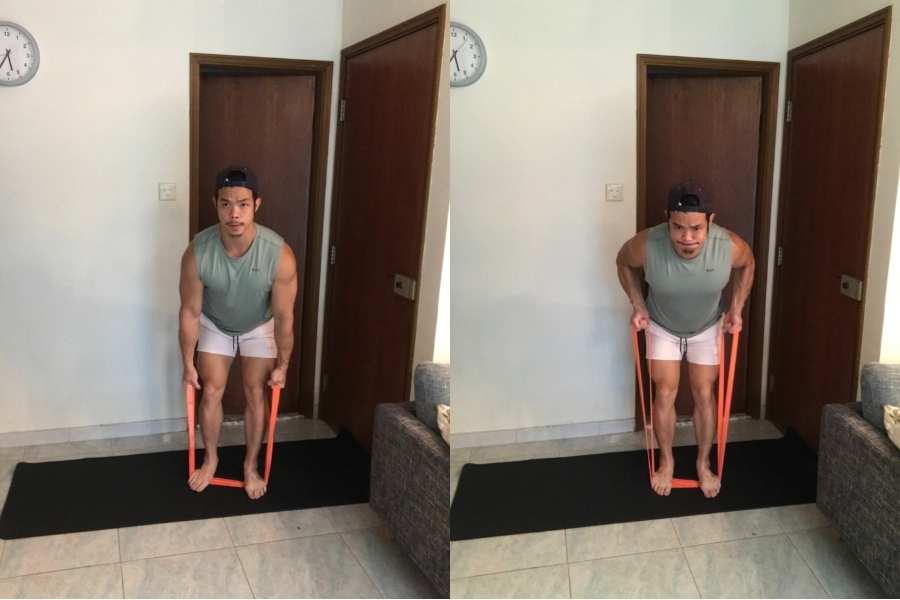
Primary muscles worked:
- Latissumus dorsi.
- Rhomboids.
- Trapezius.
- Biceps.
Secondary muscles worked:
- Core.
- Shoulders.
- Chest.
How to do it:
- Use both feet to stand in the middle of a resistance band.
- Grab both ends of the band using both hands.
- Bend the knees, sit slightly backward, and incline your torso forwards.
- Keep a straight lower back and pull the resistance band towards the navel (belly button).
Why it’s a great resistance band alternative to replace pull-ups and chin-ups:
Unlike the two pull-down movements mentioned above, this is not strictly a direct pull-up replacement using your resistance bands.
However, it’s still a great alternative to pull-ups if you don’t have a bar and only have resistance bands.
Just like the pull-up and chin-up, the row is a compound movement that works all of the muscles in your back.
It’s a great way to use your resistance bands to replace a pull-up without actually having to do a pull-up per se!
4) Sitting Resistance Band Row
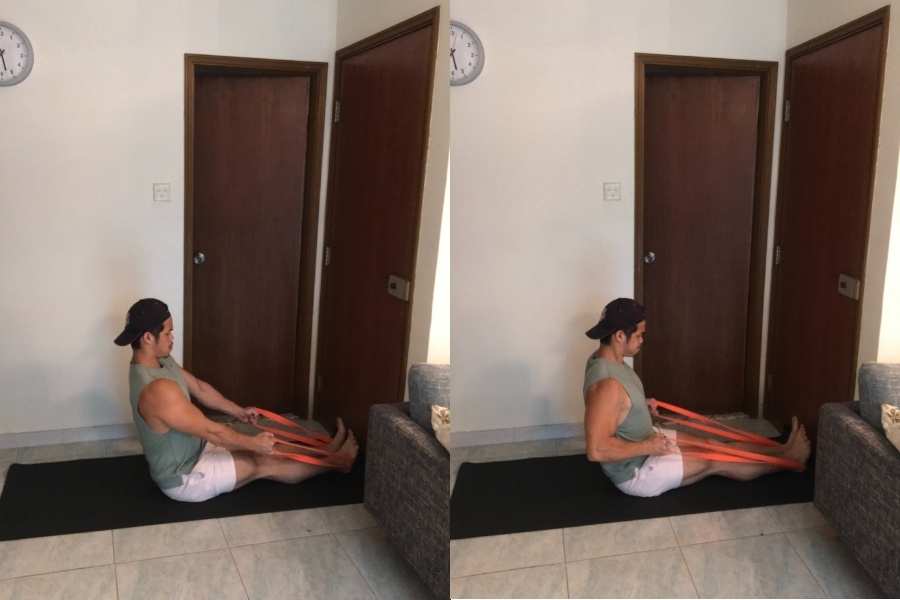
Primary muscles worked:
- Latissumus dorsi.
- Rhomboids.
- Trapezius.
- Biceps.
Secondary muscles worked:
- Core.
- Shoulders.
- Chest.
How to do it:
- Sit on the floor in an upright position and extend your legs 90° to the torso.
- Anchor the middle of a resistance band to the soles of your feet by using the friction generated from keeping the band taught.
- Grab the band with a neutral grip (palms facing each other) and pull the band towards the stomach.
- Retract your shoulder blades to get full activation in the back muscles.
Why it’s a great resistance band alternative to replace pull-ups and chin-ups:
This is another great pull-up alternative that you can do with your resistance bands.
It’s similar to the banded bent-over row (see above).
But this variation takes pressure away from the lower back and emphasizes the upper back.
If you want to use your resistance bands for a chin-up alternative, simply switch the neutral grip to an underhand grip.
This simulates the movement of a chin-up and emphasizes biceps activation!
5) Incline Reverse Resistance Band Fly
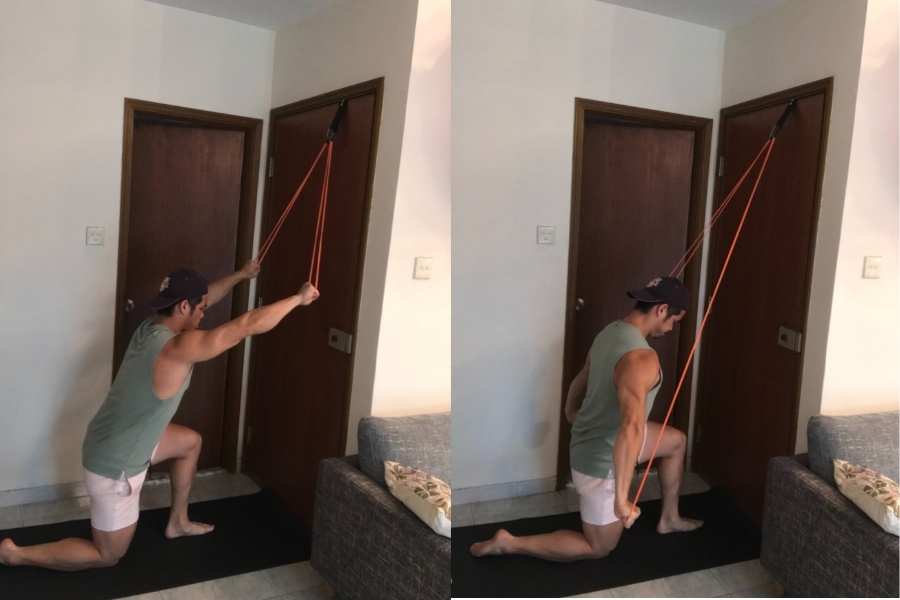
Primary muscles worked:
- Latissumus dorsi.
Secondary muscles worked:
- Rhomboids.
- Trapezius.
- Biceps.
- Shoulders
- Chest.
- Core
How to do it:
- Anchor a resistance band above your head (e.g. to the top of a sturdy door).
- Use both hands to grab both ends of the band.
- Keep a near-straight arm (slight bend in the elbows).
- Arc both arms backward and downwards whilst simultaneously retracting the shoulder blades.
Why it’s a great resistance band alternative to replace pull-ups and chin-ups:
This is another resistance band exercise that’s not a strict replacement for a pull-up but a good way to simulate the pull-up movement.
My favorite thing about the reverse incline band fly is that it isolates the latissimus dorsi (“lats”).
The lats are one of the primary muscles involved in the pull-up and chin-up.
So by specifically targeting the lats, the reverse incline band fly can develop your overall pulling strength and help you to progress onto assisted and unassisted pull-ups!
If you’re looking to get resistance bands for assisted pull-ups, you may not want to miss my other post which explains what size band is required for pull-ups!
6) Standing Reverse Band Fly
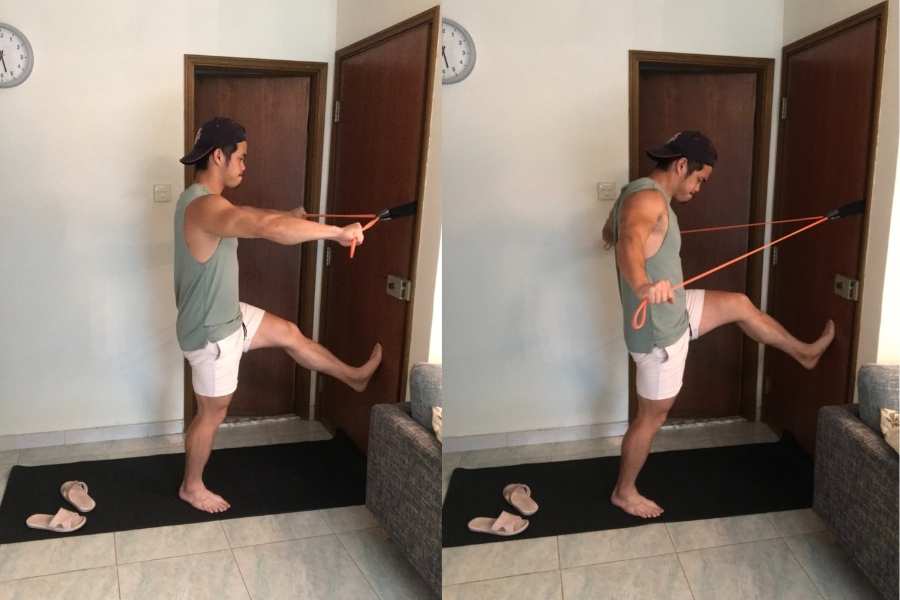
Primary muscles worked:
- Latissumus dorsi.
- Rhomboids.
- Trapezius.
Secondary muscles worked:
- Biceps
- Core.
- Shoulders.
- Chest.
How to do it:
- Anchor a resistance band to a chest-height position (e.g. to the middle of a door).
- Grab both ends of the band using both hands.
- Keep a slight bend in the elbows.
- Arc both arms backward whilst making sure not to flex the arms.
Why it’s a great resistance band alternative to replace pull-ups and chin-ups:
This is another movement that you can do with resistance bands which isn’t a direct replacement for a pull-up but replicates the same muscle activation.
The standing reverse fly is generally a lot easier than the pull-up.
But it’s still very effective for targeting the back muscles, with emphasis on the rhomboids.
7) Resistance Band Pull-Aparts
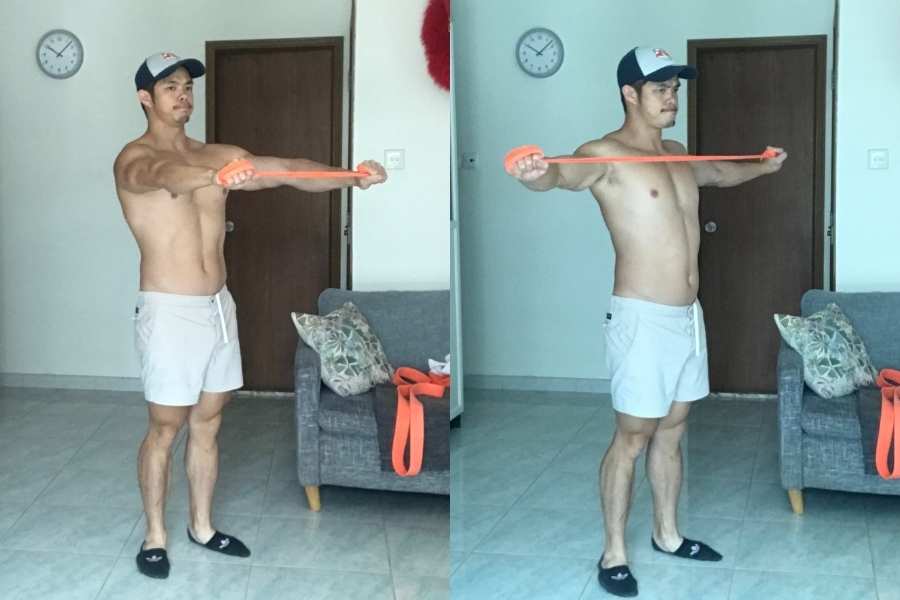
Primary muscles worked:
- Latissumus dorsi.
- Rhomboids.
- Trapezius.
Secondary muscles worked:
- Core.
- Shoulders.
How to do it:
- Use both hands to grab either end of a resistance band.
- Hold the band horizontally taught in front of your chest.
- Arc both arms backward in the horizontal plane whilst making sure not to flex the elbows.
- Retract the shoulder blades for maximal back muscle activation.
Why it’s a great resistance band alternative to replace pull-ups and chin-ups:
This is a relatively easy movement that can be done with resistance bands to replace the pull-up.
Whilst overall muscle activation is not comparable to an actual pull-up or chin-up, the pull-apart can be a great substitute for someone who cannot yet master the former two exercises.
It will work all your back muscles, with an emphasis on the rhomboids.
What’s The Best Resistance Band Alternative To Replace Pull-Ups?
Resistance band exercises like the pull-down, row, reverse fly, and pull-apart are good alternatives to the pull-up. However, assisted and unassisted pull-ups are still the most effective movement to build muscle and strength in the back muscles.

7 of my favorite pull-up substitute exercises have been shared above.
But ultimately, the pull-up is still THE most effective of back exercises (in my opinion)
And as effective as the replacement band exercises are, they are still no match for the pull-up and chin-up.
Therefore I’d always recommend eventually progressing onto unassisted pull-ups/chin-ups.
An example progression plan could involve:
- Start with a variety of resistance band pull-up alternatives.
- Progress onto band-assisted pull-ups.
- Remove the band and master the unassisted pull-up.
Benefits Of Doing Resistance Band Pull-Ups
Resistance band pull-ups typically benefit beginners who cannot yet perform the unassisted pull-up. This movement is highly effective for activating all of the upper-body muscles, with an emphasis on the back. It is commonly used to build muscle, increase strength, and lose fat.
The pull-up and chin-up are two of the most popular exercises out there.
And for a good reason.
All of the muscles in your back- and to a certain extent the entire upper body- are activated in one fell movement.
This makes the pull-up and chin-up great for a variety of purposes, including:
- Building upper-body muscle. The difficult nature of this exercise makes it great for building muscle, particularly in the back and arms.
- Increasing upper-body pulling strength. The vertical pulling movement of a pull-up makes it great for improving your functional pulling strength.
- Improving core stability. Your abs are engaged to keep your torso straight during the movement.
- Burning fat and getting lean. Your entire upper body is more or less activated during the movement. This is great for quickly burning a lot of calories.
The problem is that a lot of beginners cannot do the unassisted bodyweight pull-up or chin-up.
That’s where resistance bands come in.
You can use them to perform the 7 pull-up alternatives shared above.
Then, once you’ve built a foundation of strength, you can try doing banded pull-ups (using the resistance bands for assistance).
And when you’re ready, you can progress onto unassisted pull-ups!
Why I Recommend The Undersun Resistance Bands For Pull-Up Alternatives
Having gone through more than half a dozen different brands throughout my 5 years of experience with bands, these are the ones I recommend to friends and family.
They may not be the most expensive, but they sure as hell pack a good value punch.
Each band in the set (5 bands going from extra light to extra heavy) is protected by a lifetime warranty.
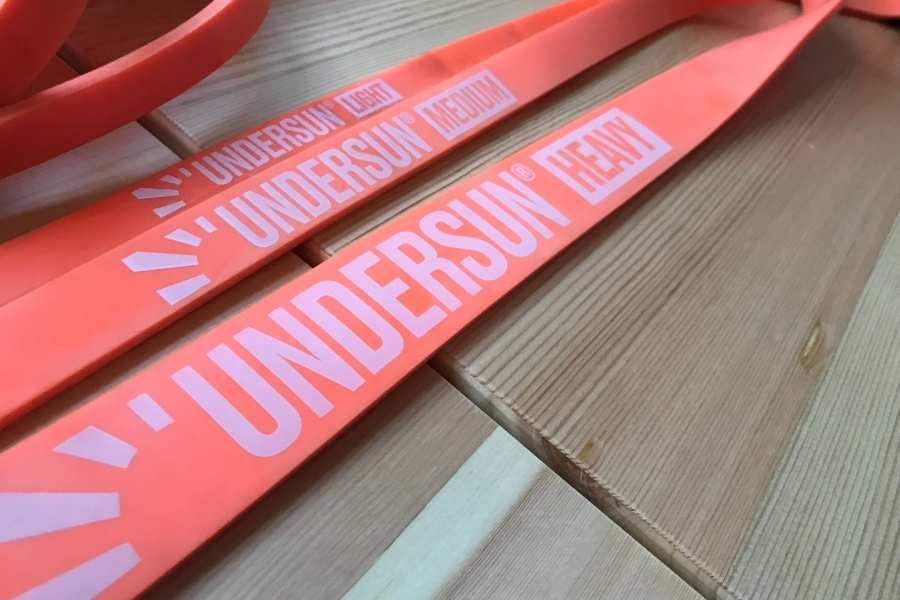
They’re also durable enough and perfectly sized to handle band-assisted pull-ups as well as the pull-up substitute exercises given in this article.
If you don’t want the headache of choosing individual bands that can handle both of the aforementioned roles, then the Undersun set is affordable and versatile!
Conclusion
I’ve shared 7 of my favorite pull-up alternatives you can do with resistance bands.
If you struggle to do normal pull-ups and chin-ups, then these movements make for great substitutes.
You can try any of these 7 exercises instead of assisted banded pull-ups and unassisted bodyweight pull-ups.
Just be aware that whilst these exercises may simulate the pull-up/chin-up movement, they are not direct replacements.
At the end of the day, the pull-up is one of the most powerful upper body exercises you can do.
So there’s no real substitute.
So I would always recommend that you try your best to progress onto band-assisted pull-ups and then unassisted pull-ups ASAP!
Which of these resistance band pull-up alternatives will you be trying?
Feel free to send me a message if you have any questions! You can find my details on the “contact us” page.
You may also be interested in the downloadable Kalibre Blueprint PDF which details exactly how I gained 40lbs of lean muscle (it’s 100% free!). It details the exact exercises and nutrition (with printable worksheets) I used to go from skinny to ripped!
Thanks for reading guys!
Peace Out,
Kal
(Biochemistry BSc, Biomedical Sciences MSc, Ex-Skinny Guy)


